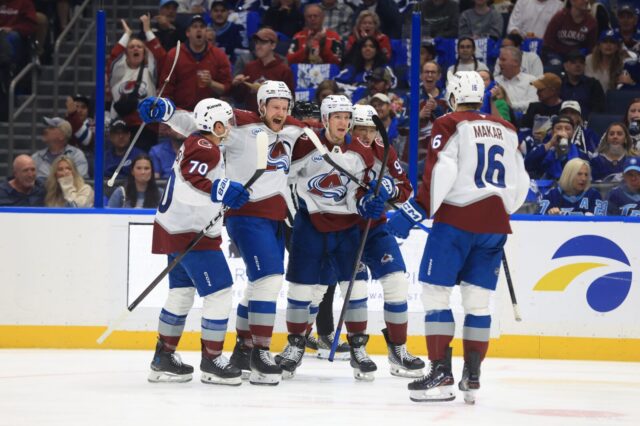It’s pretty crazy to think that we’re already around the halfway point from when the Dallas Stars eliminated the Avalanche and the start of training camp. The offseason is basically half over and my observations on the state of the Avalanche will continue until camp.
Read previous Avalanche Offseason Thoughts
7/7: Mittelstadt/Drouin deals, depth additions & veteran presence
7/12: Jonathan Drouin won’t “mess” with happy
For today, we’ll look at two looming contract extensions. Although one is going to end up far more lucrative than the other, you could argue both of these players are very valuable pieces to the team in their own way.
1: Mikko Rantanen has been eligible to sign an extension since July 1. The star winger is coming off his second straight 100+ point season and set an Avalanche single-season record when he scored 55 goals in 2022-23. Colorado’s top forward not named Nathan MacKinnon is a pending unrestricted free agent come July 2025. But barring something crazy happening, I don’t see a scenario where he’s not signed before then.
It’s no question, Rantanen is due for a raise and will enter the eight-digit salary sphere like MacKinnon. Currently making $9.2 million per year, I’d expect Rantanen’s new contract to be a top-five highest-paid deal at the time it’s signed — although this is strictly speculation on my part. Auston Matthews is set to make $13.25 million next season, which passes second place Nathan MacKinnon ($12.6 million). The only other player in the 12s is Connor McDavid, who is entering the seventh of an eight-year deal making $12.5 million. His extension will blow past MacKinnon and Matthews.
But anyway, after McDavid, the next highest is Artemi Panarin, who comes in at an AAV of $11,642,857. After him, it’s Elias Pettersson at $11.6 million to round out the top five. Rantanen could very well become the fourth player to sign an AAV in the 12s. But I wonder if the Avs could convince him to sign at $11.75 million and become the highest-paid NHLer not named Matthews, MacKinnon, or McDavid. At least until Leon Draisaitl signs his whopper of a deal.
It’s not going to be an easy negotiation for Colorado and it’s definitely expected to be a big ticket. But I think planning for Rantanen’s raise isn’t quite as tough as when MacKinnon got his. With Rantanen already making 9.2 million, a raise to $12 million is $2.8 million that you need to account for from elsewhere. That’s slightly less than the $3.15 million raise Devon Toews got on his new deal, which kicks in next season.
When MacKinnon signed his extension, his salary jumped by more than $6 million. And since his contract began in a flat cap year, it accounted for an even bigger percentage of the remaining cap. Rantanen’s deal won’t have quite the same effect on the rest of the roster. Which is good news for the Avs.
2: The second contract that’s up for renewal following the 2024-25 season is Logan O’Connor. He’s technically also eligible to sign an extension now, but players of his ilk don’t often sign a year out as the superstars do. The bottom-six energy forward had a spectacular 2023-24 season for his standard before an injury ended his season in March. O’Connor finished with a career-high 13 goals and added 12 assists in 57 games. He also recorded a three-game short-handed goal-scoring streak early in the year and his first career hat trick in Philadelphia. Of his six career game-winning goals, four of them came last year.
All that for just $1.05 million with another year at the bargain price left on his deal? Impeccable work by Joe Sakic in 2021.
O’Connor has slowly elevated his play from a permanent fourth liner to someone you can’t really take out of the top nine anymore. He fit in nicely last year with Ross Colton and Miles Wood on the third line, albeit he was the main driver of that trio. Both Colton and Wood saw their defensive metrics suffer when O’Connor was out.
He’s expected to be healthy and ready to go for camp in two months. And assuming this season goes well, I could see O’Connor basically tripling his current salary. It’s just a matter of Colorado making space for him.
3: Speaking of which, I always love seeing how contracts are structured when they’re signed. We all remember being shocked in 2023 when the Avs signed Wood to a six-year deal on the opening day of free agency. And it came in a year where teams weren’t handing out term to UFAs as commonly. But when you dig a little deeper into the structure of the deal, you’ll be able to figure out what Colorado was trying to do.
General manager Chris MacFarland told us at the time that the lengthy-term helped bring the AAV down, which a cap-strapped team like the Avs desperately needed. The first two years of the deal were set up to pay Wood $3.25 million. The third year is $2.5 million before it drops to $2 million in years 4-6. More interestingly, Wood has a six-team no-trade clause that kicks in on July 1, 2025.
That says to me that the Avs probably wanted Wood for two years at $3.25 million. So if they decide to trade him next summer to make space for O’Connor, they could do so before July 1 and avoid the six-team no-trade list. It’ll cost the acquiring team $8.5 million for four years of Wood’s services. Not bad.
It’s not a guarantee that this scenario plays out. But it’s always fascinating to see why teams agree to the structure that’s put in place. Another similar example is Josh Manson. He signed for four years with a $4.5 million AAV after winning the Stanley Cup. But the first two years included a full no-trade clause and a combined $10.5 million salary before it drops to $7.5 million in the final two years along with a 12-team no-trade list.
That says to me that perhaps the Avs were setting themselves up with an easier trade asset in the third and fourth years of the deal, which begins this upcoming season. Don’t forget, however, that Sportsnet Insider Elliotte Friedman reported earlier in the summer that teams were calling about Manson and the Avs had no interest in trading him. So if this were to happen, something would need to change.



